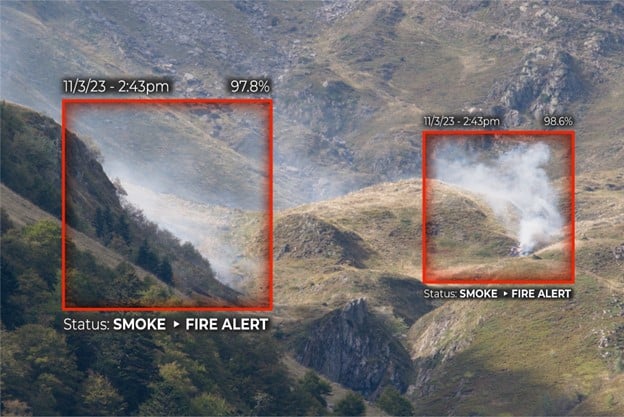
In an era where artificial intelligence (AI) is emerging as a force for innovation across diverse fields, there are new computer vision applications for environmental monitoring in a number of industries. Matroid’s state-of-the-art Computer Vision technology pairs with cameras and sensors to collect data, and to identify and track objects, events, and environmental changes. This comprehensive information serves as a foundation to recognize patterns as well as anomalies and make informed decisions regarding environmental management and protection, exemplifying the synergy between AI innovation and ecological preservation.
This piece explores how Matroid’s advanced Computer Vision is revolutionizing environmental monitoring. In the renewable energy sector, it optimizes the performance of wind turbines and solar farms. In regions prone to wildfires, Matroid’s AI-driven systems enable early fire detection, safeguarding ecosystems and communities. The technology is also being used to monitor smokestack emissions, ensuring real-time compliance with environmental regulations. Lastly, CV flood monitoring provides a proactive approach to mitigate the impact of floods, protecting infrastructure and saving lives.
Monitoring Wind Turbines with AI Visual Inspection: Enhancing Efficiency and Safety
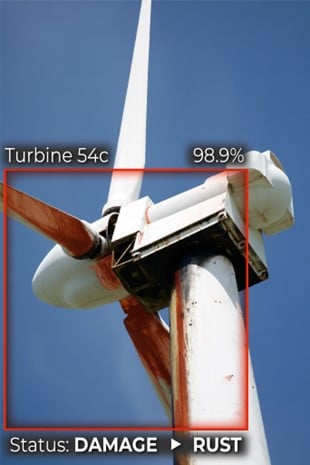
Wind energy is a pivotal player in the renewable energy landscape, with wind turbines operating in all 50 states generating more than 10 percent of the net total of the country’s energy in 2022, according to the US Department Energy Efficiency & Renewable Energy.
In the realm of monitoring and maintenance of these turbines, Matroid’s AI Computer Vision is a true innovator. The visual inspection software has proven adept at scrutinizing wind turbines for damage, wear and tear, and potential issues, ultimately averting costly failures and ensuring optimal turbine performance.
The shortcomings of traditional manual inspection, characterized by its time-consuming, expensive, and hazardous nature, necessitate a more advanced approach.
Unmanned aerial vehicles (UAVs) are a cost-effective and safe alternative for wind turbine inspection. However, the analysis of visual data collected by UAVs has not been without challenges as it is a time-consuming process which needs the input of skilled professionals.
The Matroid solution involves employing object detection to automate the analysis process. This innovative application of AI Computer Vision streamlines the identification of defects in wind turbines, offering a proactive and efficient means of ensuring the longevity and effectiveness of these crucial components of renewable energy infrastructure.
Enhancing Solar Farm Efficiency through AI Computer Vision Monitoring
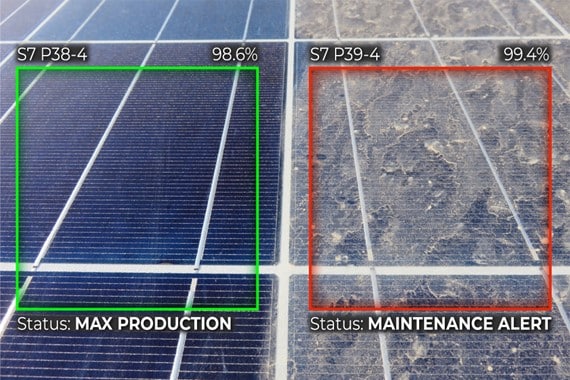
In the National Renewable Energy Laboratory’s Best Practices for Operation and Maintenance of Photovoltaic and Energy Storage Systems, the authors noted that by adopting a standardized approach to operations and maintenance (O&M), there would be a boost in the average performance ratio of solar systems, leading to higher revenue and environmental benefits.
This optimization of solar energy production depends, in part, on maintaining the pristine condition of solar panels, and Matroid’s AI Computer Vision proves instrumental in achieving this objective.UAVs, or unmanned aerial vehicles, can capture contactless aerial images, providing solar farm operators with a comprehensive overview. By utilizing advanced algorithms, Matroid’s software employs a synergistic combination of Deep Learning, Machine Learning, and Computer Vision algorithms to process these images captured. The end result is a meticulous examination of solar panels, detecting and addressing issues such as dirt, debris, and blockages that could compromise electricity generation.
Matroid’s computer vision software stands out in pinpointing anomalies, such as darker or lighter areas, in thermal images of solar batteries – essentially arrays of panels. This methodical approach not only guarantees optimal electricity generation but also demonstrates the versatility and efficacy of AI in preserving the efficiency and longevity of solar energy infrastructure.
Early Fire Detection Empowered by AI Computer Vision

From 2017 to 2021, wildfires resulted in $81.6 billion in damages, as reported by the National Oceanic and Atmospheric Administration (NOAA). This marks a nearly tenfold surge compared to the period from 2012 to 2016, during which damages amounted to $8.6 billion.
The vital need for swift fire detection in diverse environments meets a real solution in Matroid’s AI Computer Vision. Whether in forests, grasslands or other outdoor settings, the software plays an important part in identifying incidental fires.
The process begins with the analysis of video scenes using Matroid’s algorithms, which systematically locate areas exhibiting movement. Leveraging a sophisticated perceptron, a type of artificial neural network component, the algorithms extract fire-colored pixels from these regions, initiating the identification process. To further confirm the presence of fire, dynamic texture analysis comes into play, scrutinizing the temporal and motion characteristics of the identified fire-colored regions.
The application extends to a range of environments, providing an early warning system that facilitates the swift extinguishing of fires. A proactive approach, powered by AI Computer Vision, can minimize damage and save lives.
Proactive Air Pollution Mitigation: Matroid’s AI in Detecting Smoke Stack Emissions
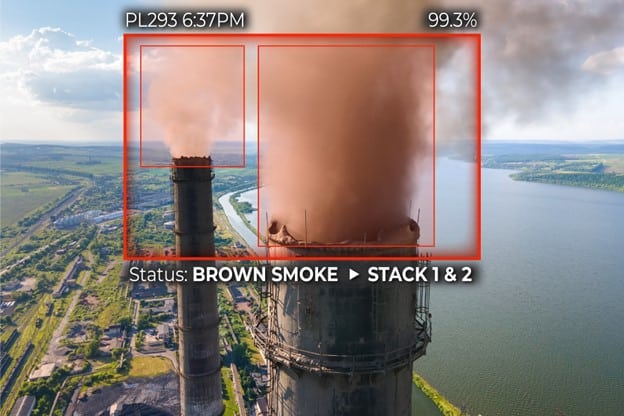
Since 2011, the EPA reports a consistent and prolonged decline in greenhouse gas (GHG) emissions from the industrial sector. However power plants, followed by petroleum and natural gas systems are still the two largest stationary sources of U.S. greenhouse gas emissions..
In the ongoing battle against air pollution, the monitoring of smoke stack emissions from industrial sources is a necessity. Matroid’s AI technology is a powerful tool in this endeavor, specializing in the identification of changes in particle release for efficient detection of pollution sources. Similar to its prowess in smoke detection, AI computer vision plays a crucial role in discerning alterations in the quantity of particles released from factories and power plants.
This capability is pivotal in pinpointing and addressing sources of air pollution promptly. By adopting this proactive approach, Matroid’s AI facilitates timely interventions, minimizing the environmental impact of air pollution. This dual-purpose application not only exemplifies the versatility of AI computer vision but also underscores its role as a critical asset in the pursuit of cleaner, healthier air quality.
Safeguarding Water Resources: Matroid’s AI in Real-Time Flood Monitoring
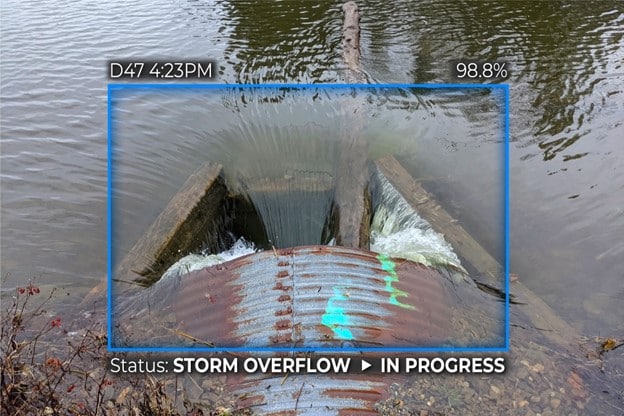
A report by the Environmental Protection Agency talks about the multiple challenges that drinking water and wastewater utilities face, including power loss, asset damage, and risks to personnel. With the increasing frequency and intensity of storms and rising sea levels, flooding is anticipated to persist as a persistent challenge for these utilities.
In the realm of water resource protection, Matroid’s computer vision works to monitor water stations for potential flooding and related issues. CV safeguards water supplies and prevents infrastructure damage by offering constant, real-time monitoring of water stations. In the face of natural disasters, especially severe flooding, which can lead to catastrophic losses, Matroid’s AI ensures a vigilant approach.
Companies who turn to Matroid to tackle crucial monitoring challenges at their wastewater treatment facilities grapple with complexities in managing water quality and asset health. By harnessing smart cameras equipped with advanced AI capabilities, these facilities can improve efficiency, reduce manual work, maintain high water treatment standards, and proactively address environmental concerns for continuous high-quality service to their communities..
For storm discharge river impact monitoring, wireless cameras integrated with Matroid’s AI offer real-time monitoring of a storm tank’s water level and its discharge into the nearby rivers, promptly identifying visible impacts on the river, including debris and water quality changes.
Another use involves turbidity, or the process of monitoring the clarity or cloudiness of the water in the treated waste discharged from wastewater treatment facilities. Traditionally reliant on time-consuming and resource-intensive manual checks using an X-tube, Matroid’s solution uses smart cameras to continuously monitor water clarity and color in the channel leading to the final discharge point, automating turbidity assessment and reducing the need for manual interventions.
Smart cities can adopt these video-based setups or utilize existing camera infrastructure to enhance security camera systems and make flood monitoring more streamlined and effective. In a very tangible way, Matroid’s CV blunts the broader human and environmental impact of flooding events.
Unveiling the Advantages: The Benefits of AI Computer Vision in Environmental Monitoring
As technology advances, the role of AI-powered computer vision in environmental monitoring becomes increasingly pronounced. Matroid’s solution is not simply about vision; it’s about better enabling computers to perceive and comprehend the intricacies of our ever-changing environment:
- Accuracy and Reliability: The hallmark of AI computer vision lies in its exceptional accuracy and reliability in the identification and tracking of objects, events, and environmental changes. Trained on extensive datasets of images and videos, this optical character recognition exhibits a level of precision that far surpasses human capabilities. The ability to learn and automatically identify intricate patterns makes AI computer vision a formidable ally in discerning nuances that may be challenging or impossible for human observation.
- Scalability: The scalability of AI computer vision systems is a key asset, particularly in monitoring vast areas and numerous objects simultaneously. This scalability makes them exceptionally well-suited for overseeing large-scale environmental systems, including expansive forests, oceans, and sprawling urban areas. The adaptability to monitor diverse environments on a grand scale positions AI computer vision as an invaluable tool in addressing complex ecological challenges.
- Cost-effectiveness: One of the compelling advantages of AI computer vision lies in its remarkable cost-effectiveness. When compared to traditional methods of environmental monitoring, such as labor-intensive manual inspections and ground-based sensor networks, AI computer vision systems prove to be more economically viable. This cost-effectiveness ensures that organizations can implement robust environmental monitoring without compromising accuracy or reliability, ultimately supporting a sustainable and efficient approach to ecological preservation.
Beyond Boundaries: Diverse AI Computer Vision Applications in Environmental Monitoring
As AI computer vision continues to learn, it surpasses its original capabilities and is becoming a tool for an increasing array of diverse environmental monitoring situations.
- Wildlife Monitoring: The capacity of AI computer vision to analyze vast datasets enables the object tracking of wildlife populations and their movements with precision. This wealth of information serves as a foundation for informed conservation efforts, aiding in the protection of endangered species. By offering insights into the behavior and patterns of wildlife, AI computer vision contributes significantly to the preservation of biodiversity.
For instance, it might help identify migration routes, nesting locations, or detect unusual behaviors that could indicate potential threats to a species.
- Habitat Monitoring: The health of habitats and changes in vegetation cover come under the perceptive gaze of AI computer vision in habitat monitoring. This technology provides a nuanced understanding of ecological systems, allowing for the assessment of the impact of climate change and other environmental stressors. By monitoring alterations in vegetation cover, AI computer vision becomes an essential tool in understanding and mitigating the effects of environmental changes on ecosystems.
In the case of afforestation, where new vegetation is planted to combat deforestation, AI computer vision can monitor the success of these initiatives by tracking the growth and health of newly planted trees. This real-time data is invaluable for understanding the effectiveness of conservation efforts and making informed decisions to mitigate the adverse effects of environmental changes on ecosystems.
- Pollution Monitoring: Addressing the global concern of pollution, AI computer vision proves instrumental in monitoring air and water quality. By scrutinizing signs of pollution in real-time, this technology aids in the identification of pollution sources. Armed with this information, proactive steps can be taken to reduce environmental degradation. The application of AI computer vision in pollution monitoring underscores its potential in creating cleaner and healthier environments, aligning with global efforts to combat pollution and its adverse effects on ecosystems and human health.
As an example, AI computer vision can be employed to monitor water bodies for signs of pollution, such as changes in water color, presence of contaminants, or abnormal aquatic behavior. This real-time surveillance allows for rapid response to pollution events, facilitating timely interventions to safeguard aquatic ecosystems and ensure the availability of clean water resources.
Matroid’s AI-driven environmental monitoring solutions are paving the way for a more sustainable and resilient future. By leveraging the power of Computer Vision, organizations can enhance the efficiency, accuracy, and cost-effectiveness of their environmental management and conservation efforts. As we stand at the intersection of technology and environmental stewardship, Matroid’s innovative solutions offer a glimpse into a future where AI can safeguard the health and balance of our planet.
Download Our Free
Step By Step Guide
Building Custom Computer Vision Models with Matroid
Dive into the world of personalized computer vision models with Matroid's comprehensive guide – click to download today